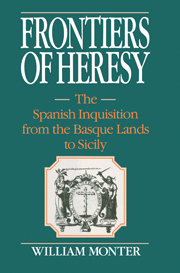Book contents
- Frontmatter
- Contents
- List of maps and figure
- List of tables
- Preface
- PART 1 THE HOLY OFFICE OUTSIDE CASTILE
- PART 2 ARAGONESE TRIBUNALS
- 4 Saragossa: a royal fortress
- 5 Barcelona: Inquisitors with short arms
- 6 Valencia: taming the magnates
- 7 Navarre: the four conspiracies
- 8 Sicily: Italian wine in Spanish bottles
- PART 3 ARAGONESE HERESIES
- PART 4 “MIXED CRIMES” IN ARAGON
- PART 5 RECESSIONAL
- APPENDICES
- Glossary
- Index
- CAMBRIDGE STUDIES IN EARLY MODERN HISTORY
7 - Navarre: the four conspiracies
Published online by Cambridge University Press: 24 October 2009
- Frontmatter
- Contents
- List of maps and figure
- List of tables
- Preface
- PART 1 THE HOLY OFFICE OUTSIDE CASTILE
- PART 2 ARAGONESE TRIBUNALS
- 4 Saragossa: a royal fortress
- 5 Barcelona: Inquisitors with short arms
- 6 Valencia: taming the magnates
- 7 Navarre: the four conspiracies
- 8 Sicily: Italian wine in Spanish bottles
- PART 3 ARAGONESE HERESIES
- PART 4 “MIXED CRIMES” IN ARAGON
- PART 5 RECESSIONAL
- APPENDICES
- Glossary
- Index
- CAMBRIDGE STUDIES IN EARLY MODERN HISTORY
Summary
Entendemos que Navarra, gloria a Dios, esta muy libre desta secta [Protestants].
Inquisitor Ybarra to Suprema, 1568 (Inq., Libro 786, fol. 364).En lo que toca a la fe, los naturales estan buenos, que para ser raya de Francia, donde tanta mal ay, es de dar … y lo que requiere enmienda y castigo casi todo es del Ordinario por ser supersticiones, hechicerias, adevinaciones, opiniones vanas de bruxas, sin fundamento.
Inquisitor Morel, after visita to Guipuzcoa, 1567 (Inq., Libro 785, fol. 404v).When Francis I's armies invaded Navarre in May of 1521, the local tribunal of the Inquisition fled west along the Ebro from Tudela to the nearest episcopal town, Calahorra, losing all of its prisoners and part of its records during the hasty exit. The diocese of Calahorra was immediately detached from the Valladolid Inquisition and transferred to Navarre. Barely a month later, the French reeled back in unexpected defeat, but the Holy Office continued to reside outside Navarre.
Both before and after the French invasion, the Cortes and Viceroy of Navarre had requested that the seat of their Inquisition be moved to Pamplona, capital of this small kingdom. In August 1521, the Supreme Council of the Inquisition laid down its rulings on the petitions of Navarre's Cortes. They agreed that all ordinary voting judges, the consultores and letrados, should be Navarrese, but categorically rejected the demand that Inquisitors should likewise be Navarrese.
- Type
- Chapter
- Information
- Frontiers of HeresyThe Spanish Inquisition from the Basque Lands to Sicily, pp. 143 - 163Publisher: Cambridge University PressPrint publication year: 1990



